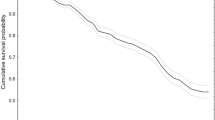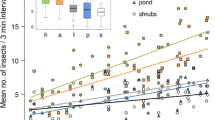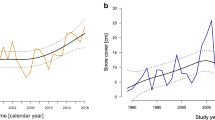Abstract
Understanding the effects climate change may have on animal populations relies on establishing which environmental conditions shape their behaviour and subsequent reproductive output, fitness or survival. South Africa has seen significant warming trends and changes in precipitation over the last few decades; however, the ways in which these trends are likely to influence animal populations are still relatively poorly understood. The Black Sparrowhawk (Accipiter melanoleucus) has expanded its range in South Africa and recently colonised the Cape Peninsula in the Western Cape, a region that experiences a Mediterranean climate. In this study, we examined the brooding behaviour of this species, a vital trait for reproductive success, in the Cape Peninsula breeding population. We examined the influence of chick age as well as temperature, rainfall and wind speed on parental brooding. Additionally, the effect of prey provisioning on brooding was investigated. In our analyses, we used data on brooding from nest cameras together with weather data collected at a fine temporal scale (1 h). The variable with the strongest influence on parental brooding was chick age. This variable showed a non-linear relationship. Initially chicks were brooded >50 % of the time; however after 3 weeks brooding declined rapidly. The proportion of time spent brooding increased with decreasing temperatures, while rainfall and wind speed showed a positive correlation with the amount of brooding. Our model predicted that in common winter conditions of the Western Cape (15 °C, 10 km/h wind speed, 1 mm/h rainfall) A. melanoleucus breeding pairs spent nearly 100 % of their time brooding young chicks (7 days old) to protect them from detrimental weather. Our results highlight measurable effects of weather patterns on avian behaviour at a key stage of the life cycle. Changes in weather conditions predicted for this region will likely further benefit this range-expanding species.
Zusammenfassung
Der Einfluss von Nestlingsalter und Wetterschwankungen auf das Brutverhalten des Mohrenhabichts auf der kürzlich besiedelten Kap-Halbinsel, Südafrika
Um die möglichen Effekte des Klimawandels auf Tierpopulationen zu ergründen ist das Verständnis der Umweltfaktoren die ihr Verhalten und die darauffolgende Reproduktion, Fitness und das Überleben bestimmen von grundlegender Bedeutung. In welcher Weise die Klimaerwärmung und Niederschlagsveränderung der letzten Jahrzehnte in Südafrika Einfluss auf die Tierpopulationen hat ist noch nicht vollständig erforscht. Der Mohrenhabicht (Accipiter melanoleucus) hat sein lokales Verbreitungsgebiet in der letzten Zeit erheblich vergrößert und auch die durch ein mediterranes Klima geprägte Kap-Halbinsel in der Provinz Westkap besiedelt. In dieser Studie haben wir das Brutverhalten der Art, ein unverzichtbarer Aspekt für die erfolgreiche Reproduktion, an der Kap-Halbinsel Population erforscht. Untersucht wurde der Einfluss des Nestlingsalters sowie von Temperatur, Niederschlag und Windgeschwindigkeit auf das Brüten der Elternvögel. Zusätzlich wurde geprüft ob die Bereitstellung von Nahrung das Brüten beeinflusste. Für unsere Analysen nutzten wir Aufnahmen von Nestkameras zusammen mit Wetterdaten auf einer sehr detaillierten Zeitskala von einer Stunde. Den stärksten Einfluss hatte das Alter der Nestlinge, welches in einem nichtlinearen Zusammenhang mit dem Brüten der Elternvögel stand. Anfangs wurden die Nestlinge durchschnittlich >50 % der Zeit bebrütet aber nach drei Wochen fiel dieser Wert rasch ab. Der Anteil der stündlichen Brutzeit war höher bei niedrigeren Temperaturen, während Niederschlag und Windgeschwindigkeit eine positive Korrelation mit dem stündlichen Brutanteil zeigten. Unser Modell prognostizierte, dass bei üblichen Wetterkonditionen im Winter des Westkaps (15 °C, 10 km/h Windgeschwindigkeit, 1 mm/h Niederschlag) Brutpaare von A. melanoleucus nahezu 100 % der Zeit mit dem Bebrüten von jungen Nestlingen (7 Tage alt) verbringen müssen, um diese vor schädlichen Wettereinflüssen schützen zu können. Unsere Ergebnisse ziehen Aufmerksamkeit darauf wie Wettereffekte das Verhalten von Vögeln in einer entscheidenden Stufe ihres Lebenszyklus beeinflussen und wie diese Effekte quantifiziert werden können. Die vorhergesagten Klimaveränderungen in der Region werden der weiteren Ausbreitung des Mohrenhabichts voraussichtlich zuträglich sein.




Similar content being viewed by others
References
Allan DG (1997) Black Sparrowhawk. In: Harrison J, Allan D, Underhill L, Herremans M, Tree A, Parker V, Brown C (eds) The atlas of Southern African birds. Avian Demogr Unit and BirdLife S. Afr, Johannesburg, pp 224–225
Amar A, Davies J, Meek E, Williams J, Knight A, Redpath S (2011) Long-term impact of changes in sheep Ovis aries densities on the breeding output of the hen harrier Circus cyaneus. J Appl Ecol 48:220–227
Amar A, Court IR, Davison M, Downing S, Grimshaw T, Pickford T, Raw D (2012) Linking nest histories, remotely sensed land use data and wildlife crime records to explore the impact of grouse moor management on peregrine falcon populations. Biol Conserv 145:86–94
Amar A, Koeslag A, Curtis O (2013) Plumage polymorphism in a newly colonized black sparrowhawk population: classification, temporal stability and inheritance patterns. J Zool 289:60–67
Amar A, Koeslag A, Malan G, Brown M, Wreford E (2014) Clinal variation in the morph ratio of Black Sparrowhawks Accipiter melanoleucus in South Africa and its correlation with environmental variables. Ibis 156:627–638
Bolton M, Butcher N, Sharpe F, Stevens D, Fisher G (2007) Remote monitoring of nests using digital camera technology. J Field Ornithol 78:213–220
Brown LH, Brown BE (1979) The behaviour of the black sparrowhawk Accipiter melanoleucus. Ardea 67:77–95
Butchart SHM, Walpole M, Collen B, van Strien A, Scharlemann JPW, Almond REA, Baillie JEM, Bomhard B, Brown C, Bruno J, Carpenter KE, Carr GM, Chanson J, Chenery AM, Csirke J, Davidson NC, Dentener F, Foster M, Galli A, Galloway JN, Genovesi P, Gregory RD, Hockings M, Kapos V, Lamarque J-F, Leverington F, Loh J, McGeoch MA, McRae L, Minasyan A, Hernández Morcillo M, Oldfield TEE, Pauly D, Quader S, Revenga C, Sauer JR, Skolnik B, Spear D, Stanwell-Smith D, Stuart SN, Symes A, Tierney M, Tyrrell TD, Vié J-C, Watson R (2010) Global biodiversity: indicators of recent declines. Science 328:1164–1168
Byholm P, Rousi H, Sole I (2011) Parental care in nesting hawks: breeding experience and food availability influence the outcome. Behav Ecol 22:609–615
Cain SL (2008) Time budgets and behavior of nesting Bald Eagles. In: Wright BA, Schempf PF (eds) Bald Eagles in Alaska, pp 73–94
Carey C (2009) The impacts of climate change on the annual cycles of birds. Philos Trans R Soc Lond B Biol Sci 364:3321–3330
Christensen JH, Hewitson B, Busuioc A, Chen A, Gao X, Held I, Jones R, Kolli RK, Kwon W-T, Laprise R, Rueda VM, Mearns L, Menéndez CG, Räisänen J, Rinke A, Sarr A, Whetton P (2007) Regional climate projections. Climate change 2007: the physical science basis. Contribution of Working Group I to the Fourth Assessment Report of the Intergovernmental Panel on Climate Change. Cambridge University Press, Cambridge, United Kingdom and New York, NY, USA, pp 848–940
Collopy MW (1984) Parental care and feeding ecology of Golden Eagle nestlings. Auk 101:753–760
Core Team R (2013) R: A language and environment for statistical computing. R Foundation for Statistical Computing, Vienna, Austria
Crick HQP (2004) The impact of climate change on birds. Ibis 146:48–56
Curtis O, Malan G, Jenkins A, Myburgh N (2004) Multiple-brooding in birds of prey: South African black sparrowhawks Accipiter melanoleucus extend the boundaries. Ibis 147:11–16
Curtis O, Hockey PAR, Koeslag A (2007) Competition with Egyptian geese Alopochen aegyptiaca overrides environmental factors in determining productivity of black sparrowhawks Accipiter melanoleucus. Ibis 149:502–508
de Lily-Arison R R (2000) Breeding biology of Frances’s Sparrowhawk Accipiter francesii in a lowland rainforest of northeastern Madagascar. Ostrich 71:332–335
Debus S, Hatfield T, Ley A, Rose A (2007) Breeding biology and diet of the Wedge-tailed Eagle Aquila audax in the New England region of New South Wales. Aust F Ornithol 24:93–120
Del Hoyo J, Elliott A, Sargatal J (1994) Handbook of the birds of the world. Vol 2, New world Vultures to Guineafowl. Lynx Edicions, Barcelona
Donald PGM (2004) The breeding ecology and behaviour of a colour-marked population of Brown Falcons (Falco berigora). Emu 104:1–6
Dunn EH (1980) On the variability in energy allocation of nestling birds. Auk 97:19–27
Dykstra C, Hays J, Simon M, Daniel F (2003) Behavior and prey of nesting Red-shouldered Hawks in southwestern Ohio. J Raptor Res 37:177–187
Elkins N (1983) Weather and bird behaviour. Poyser, Calton
Griffin C, Paton P, Baskett T (1998) Breeding ecology and behavior of the Hawaiian Hawk. Condor 100:654–662
Hartley RR, Hough J (2004) Breeding, ecology and human impacts on the Black Sparrowhawk in Zimbabwe—1971–1980. Honeyguide 50:125–142
Hockey PAR, Midgley GF (2009) Avian range changes and climate change: a cautionary tale from the Cape Peninsula. Ostrich 80:29–34
Hockey PAR, Dean WRJ, Ryan PG (2005) Roberts—birds of southern Africa, 7th edn. Trustees of the John Voelcker Bird Book Fund, Cape Town
Hockey PAR, Sirami C, Ridley AR, Midgley GF, Babiker HA (2011) Interrogating recent range changes in South African birds: confounding signals from land use and climate change present a challenge for attribution. Divers Distrib 17:254–261
Hoffmann AA, Sgrò CM (2011) Climate change and evolutionary adaptation. Nature 470:479–485
Jenkins M (1978) Gyrfalcon nesting behavior from hatching to fledging. Auk 95:122–127
Jenkins A (2000) Variation in the quality of parental care at falcon nests in South Africa as evidence for postulated differences in food availability. Ardea 88:17–32
Kross SM, Tylianakis JM, Nelson XJ (2012) Translocation of threatened New Zealand falcons to vineyards increases nest attendance, brooding and feeding rates. PLoS ONE 7:e38679
Kruger AC, Shongwe S (2004) Temperature trends in South Africa: 1960–2003. Int J Climatol 24:1929–1945
Leckie FM, Arroyo BE, Thirgood SJ, Redpath SM (2008) Parental differences in brood provisioning by Hen Harriers Circus cyaneus. Bird Study 55:209–215
Lehikoinen A, Byholm P, Ranta E, Saurola P, Valkama J, Korpimäki E, Pietiäinen H, Henttonen H (2009) Reproduction of the common buzzard at its northern range margin under climatic change. Oikos 118:829–836
Levenson H (1979) Time and activity budget of Ospreys nesting in northern California. Condor 81:364–369
Lyons DM, Mosher JA (1987) Morphological growth, behavioral development, and parental care of Broad-winged Hawks. J Field Ornithol 58:334–344
Madden C (2013) The impacts of Corvids on Biodiversity. Unpublished MSc thesis, University of Cape Town
Martin TE (1987) Food as a limit on breeding birds: a life-history perspective. Annu Rev Ecol Syst 18:453–487
Martin R, Sebele L, Koeslag A, Curtis O, Abadi F, Amar A (2014) Phenological shifts assist colonisation of a novel environment in a range-expanding raptor. Oikos. doi:10.1111/oik.01058
MCDonald PG, Olsen PD, Cockburn A (2004) Weather dictates reproductive success and survival in the Australian brown falcon Falco berigora. J Anim Ecol 73:683–692
Mearns R, Newton I (1988) Factors affecting breeding success of peregrines in South Scotland. J Anim Ecol 57:903–916
Midgley GF, Hannah L, Millar D, Thuiller W, Booth A (2003) Developing regional and species-level assessments of climate change impacts on biodiversity in the Cape Floristic Region. Biol Conserv 112:87–97
Moss D (1979) Growth of nestling sparrowhawks (Accipiter nisus). J Zool 187:297–314
Nakagawa S, Schielzeth H (2013) A general and simple method for obtaining R 2 from generalized linear mixed-effects models. Methods Ecol Evol 4:133–142
Newton I (1978) Feeding and development of sparrowhawk Accipiter nisus nestlings. J Zool 184:465–487
Newton I (1986) The Sparrowhawk. Poyser, Calton
Oettlé E (1994) Black sparrowhawk breeds on the Cape Peninsula. Promerops 212:7
Olsen P, Olsen J (1992) Does rain hamper hunting by breeding raptors? Emu 92:184–187
Redpath SM, Arroyo BE, Etheridge B, Leckie F, Bouwman K, Thirgood SJ (2002) Temperature and hen harrier productivity: from local mechanisms to geographical patterns. Ecography 25:533–540
Root TL, Price JT, Hall KR, Schneider SH, Rosenzweig C, Pounds JA (2003) Fingerprints of global warming on wild animals and plants. Nature 421:57–60
Schielzeth H (2010) Simple means to improve the interpretability of regression coefficients. Methods Ecol Evol 1:103–113
Sekercioglu CH, Schneider SH, Fay JP, Loarie SR (2008) Climate change, elevational range shifts, and bird extinctions. Conserv Biol 22:140–150
Sergio F (2003) From individual behaviour to population pattern: weather-dependent foraging and breeding performance in black kites. Anim Behav 66:1109–1117
Studeny AC, Buckland ST, Harrison PJ, Illian JB, Magurran AE, Newson SE (2013) Fine-tuning the assessment of large-scale temporal trends in biodiversity using the example of British breeding birds. J Appl Ecol 50:190–198
Tingley MW, Koo MS, Moritz C, Rush AC, Beissinger SR (2012) The push and pull of climate change causes heterogeneous shifts in avian elevational ranges. Glob Chang Biol 18:3279–3290
Visser G (1998) Development of temperature regulation. In: Starck JM, Ricklefs RE (eds) Avian growth and development: evolution within the altricial-precocial spectrum. Oxford University Press, Oxford, pp 117–156
Visser ME (2008) Keeping up with a warming world; assessing the rate of adaptation to climate change. Proc R Soc B 275:649–659
Wakeley J (1978) Activity budgets, energy expenditures, and energy intakes of nesting Ferruginous Hawks. Auk 95:667–676
Watts SH (2014) A study of nesting sparrowhawks Accipiter nisus using video analysis. Bird Study 61:428–437
Wingfield JC (1984) Influence of weather on reproduction. J Exp Zool 232:589–594
Acknowledgments
We are grateful for help with data processing from Marina Wang, Tesray Linevee, Sarah Caine, Jacques de Satgé, Jess Suri and Tumelo Morapi. Jacques de Satgé and Susie Cunningham are also thanked for comprehensive discussions and their help in improving the manuscript. Two anonymous reviewers are thanked for their comments of on a previous draft of this manuscript. For the provisioning of weather data we acknowledge the support of the South African Environmental Observation Network (SAEON). We are also grateful to Nigel Butcher (RSPB) who helped develop some of the cameras used in this study. J.K. was funded by a Deutschlandstipendium scholarship of the University of Applied Sciences Bremen.
Author information
Authors and Affiliations
Corresponding author
Additional information
Communicated by O. Krüger.
Appendix
Appendix
Rights and permissions
About this article
Cite this article
Katzenberger, J., Tate, G., Koeslag, A. et al. Black Sparrowhawk brooding behaviour in relation to chick age and weather variation in the recently colonised Cape Peninsula, South Africa. J Ornithol 156, 903–913 (2015). https://doi.org/10.1007/s10336-015-1199-0
Received:
Revised:
Accepted:
Published:
Issue Date:
DOI: https://doi.org/10.1007/s10336-015-1199-0




